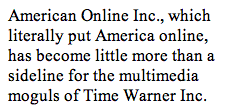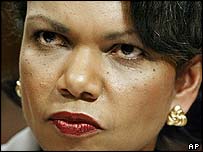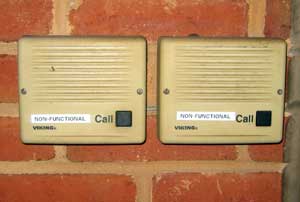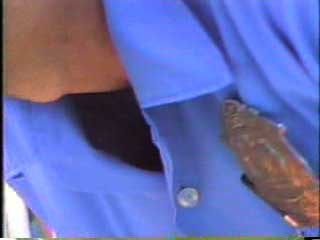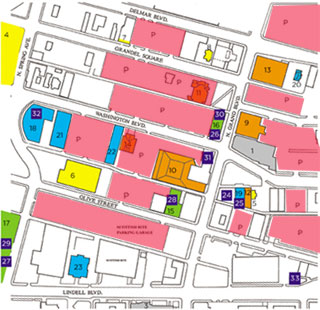
|
|
|
Monday 28 February 2005
Random Interesting Thing
Fun In The Snow
At about 4 p.m. today, we realized that we were out of bread, and that we’d have to head into town or do without sandwiches: so out in the snow we went. On our way down the hill, we were delayed for a while by a tow truck that was pulling one of our neighbors out of the ditch. The tow truck actually started out facing forward in our lane, i.e. straight but on the right-hand side of the road as you look at it in the picture. While it was trying to winch the truck out of the ditch, the back end was pulled around to the position you see here. At one point, either one of the cables broke or one of the tow hooks on the Tahoe let go, with a big BANG and flying debris. In the end, though, the truck didn’t appear to be much the worse for wear, and they drove it away. Snow Truck, :30, 1.1mb Quicktime. Posted by tino at 21:22 28.02.05
Sunday 27 February 2005
Random Interesting Thing
1994 Vintage Jerry Pournelle I was poking around Byte’s website for some reason, and I stumbled across this perfect example of vintage Jerry Pournelle’s writing about computers. When I face a computer that’s screwed up in some way that defies all logic, I often refer to it as a ‘Jerry Pournelle situation’, after the kind of thing he used to write about every month:
He had recently switched to a new monitor, and installed the After Dark screensaver into the bargain.
Bob’s your uncle. Posted by tino at 22:32 27.02.05
Friday 25 February 2005
Corporate Idiocy
Doing The Unthinkable The Headline on Forbes.com is ‘Sears, Roebuck does the unthinkable’, and I think that’s about right. Sears is changing its 119-year-old customer-satisfaction policy from ‘Satisfaction guaranteed or your money back’ to ‘Satisfaction guaranteed or your money back within 90 days’. (There’s a slightly longer version of the same story in the Sun-Times.) Hint to corporate management everywhere: when Forbes describes some decision of yours as ‘the unthinkable’, you might want to reconsider it, or at least issue a press release. Sears has, as near as I can tell, done neither. Now, from a customer-service point of view this change is actually probably a good one. The old policy wasn’t exactly unlimited: goods had to be returned ‘within a reasonable time’. What the heck is ‘reasonable’? That would depend on what you’d bought, on how it had failed to satisfy you, on your motivation for returning it, on the mood of Sears’ employees, and a whole lot of other things. Ninety days certainly seems ‘reasonable’ to me; it’s a more-generous policy than most retailers have. (I assume that this change doesn’t apply to Sears’ hand tools; Craftsman tools are some of the most expensive that you can buy in retail stores, and even cheap tools from Auto Zone are guaranteed for life. The craftsman.com website still explicitly mentions the lifetime guarantee, but the standard Sears guarantee page doesn’t mention any exceptions to the 90-day policy. If they’ve changed the guarantee on the tools, forget it: sell your Sears stock now, because they’ve just ceded their position as America’s #1 tool seller.) I can see two reasons to change the guarantee: One is to avoid liability. Imagine that two people, at different Sears stores, both try to return the same item, purchased on the same day, etc., etc. At one store, the management decides that the return is being made within a ‘reasonable’ time. At the other store, the management refuses the return. Now imagine that the person whose return is refused is a member of one or more Victim Groups, and has a lawyer who’ll work on contingency on speed-dial. It doesn’t matter why the return was refused, or what happened, or anything like that: this would cost Sears millions of dollars just in legal fees and a big settlement payout: never mind the damage to its reputation and the potential corporate ruin that could result should such a thing get certified as a class action. Second: with the unconditional guarantee, every dollar of retail revenue that Sears brings in also generates a dollar of liability: and this liability isn’t something that Sears can ever write off, because everything is, at least in theory, guaranteed forever. After more than a century, I’m sure that Sears has a pretty good idea of just how much stuff is going to be returned, and when, and that they discount their satisfaction-guarantee liability accordingly, but there’s a not-insignificant cost involved in keeping track of all that. Now they’ll be able to fully book all their retail revenue after 90 days, and they’ll have a minutely-simpler balance sheet to show the Wall Street analysts. But whatever the accounting or customer service impact, from a PR perspective this is a disaster. Every Sears store has, at at least one entrance, a plaque next to the door or gold-leaf letters on the glass above it, reading ‘Satisfaction guaranteed or your money back’. (Click on that picture to pop up a bigger version.) These will have to be removed or amended, and God help them if some newspaper gets a photo of someone prying one of those plaques off the wall. That the substance of the guarantee hasn’t changed much won’t be important when confronted with such a powerful image. The importance of the Sears guarantee came not from the fact that you could conceivably return that pair of pants when they failed to give ‘satisfaction’ because they could no longer contain your ballooning ass; the importance came from the fact that it respected the customer utterly, and because it spoke volumes about Sears’ faith in its merchandise. I avoid shopping in places that impose ‘restock fees’ on returns. In an average month, I spend thousands of dollars on electronic gadgets and supplies, both for my own use and for my clients’. Once in a while — which works out to be a few times a month — something won’t work out and it’ll need to go back. I can appreciate that these retailers are not interested in serving as a technology lending library, and I understand that there are costs involved in processing returns. Nevertheless I’m not interested in doing business with people on an unequal basis (this is Customer Service Rule #17, ‘Practice customer parity); If someone wants to collect 10% from me for ‘restocking fees’ if I return a product because I couldn’t or didn’t make sure of its usefulness to me before buying, I expect them to pay me a 10% service fee if I have to exchange anything because it’s defective. Nobody does this, and in fact attempting to do so would be a nightmare; people would take things home, break them, and come back for a 10% discount. The answer, perhaps, is not to charge ‘restocking’ fees. Sears is a long way from the restocking-fee con: 90 days is a perfectly reasonable restriction on returns. But the fact that they’re ready to give up ability to simply promise unconditional satisfaction to their customers in exchange for simpler bookkeeping suggests that Sears’ management is focused more on their internal mechanisms and procedures than on their public image and their customers. Posted by tino at 09:36 25.02.05
Monday 21 February 2005
Random Interesting Thing
There’s No More There
There’s an interesting article in the Washington Post today about the waning importance of the Washington area in the telecommunication industry:
What once was the region’s most promising growth industry has been largely reduced to a few struggling providers of phone and Internet services — more mom-and-pop than Ma Bell — and some small suppliers of hardware and services to the big boys. Washington is still important in the telecommunications industry, of course: while a lot of local operators have now been absorbed into larger companies, their operations are still here. I doubt there will be much local expansion, though, given the cost of doing business in Washingtonia. It’s really ironic how much of the business was once concentrated within a few miles, particularly considering how this is an industry that’s all about the elimination of place. Update, 15:37 21 Feb 2005: The fourth paragraph of the article shows just how in touch with the local telecommunications industry the Washington Post is: Posted by tino at 12:37 21.02.05
Media
Interesting Choice of Pictures The BBC’s website today carries a story headlined ‘Chavez says US plans to kill him’. The Beeb explicitly mentions that Mr. Chavez does not present any evidence to support this claim, but it does quote Fidel Castro as a character witness of sorts. Well okay then. The story is illustrated with an interesting pair of photos that remind me of an observation I made last month about the NBC Nightly News. The photos in this case are of Mr. Chavez and of Secretary of State Condoleezza Rice. Both of them are file photos: Mr. Chavez is smiling — or maybe grimacing, or just squinting into the sun — and making some kind of expansive gesture with his hands. Ms. Rice is shown scowling in an extreme closeup.
I know, I know, I’ve really blown the lid off this one: BBC Supports Communists, Thinks U.S. Is Source Of All Evil. I thought it was important to make a note of this, particularly in light of the complaint I made about the (much less ham-fisted) choice of pictures on the NBC Nightly News in January. Posted by tino at 10:58 21.02.05
Friday 18 February 2005
Random Interesting Thing
Non-Functional The first thing that caught my eye was the use of euphemism. Then I started to think about the utter absurdity of this:
In the end, I suppose is is cheaper to think of, print, and stock little stickers that say ‘non-functional’ (these are mass-produced, not spit out of a label maker) than it is to remove these things and patch the holes. Which got me to thinking how handy these labels could be in general. You could slap ‘em on most of the products down at the CompUSA (not to mention on the sales clerks’ foreheads); you could put them on those soap dispensers in public restrooms that seem to always be empty; you could put them on drinking fountains that have such low pressure that they just dribble water all over themselves. There are a million uses for these things. Myself, I have been meaning for some time now to print up stickers that look something like this:
I’d use them in businesses where they have double doors, but always keep one locked. Perhaps they’re waiting until the hinges wear out on the active door, whereupon they’ll lock it and switch to the locked one. Or maybe this has already happened. Posted by tino at 13:07 18.02.05
Tuesday 15 February 2005
General Idiocy
Bad, Bad Signage This is a gas pump at the Exxon station near Tino Manor. Click on the picture to pop up a bigger version: I count over 300 words in the picture — and that’s leaving out the stuff off the top and bottom of the frame, not counting the lettering that’s too small to make out in the photo, and not counting all the messages that appear on the 32-character, scrolling, all-caps LCD display. There’s also a speaker though which the attendant can make squawking noises at you should you somehow require information on a topic that’s not already covered by one or more of the stickers. Incidentally, at the far right of the frame are a number of miniature credit cards, assuring you that you can pay for your gas with, among other things, a Diner’s Club card, or Carte Blanche, or a number of credit cards I’ve never even heard of, or a JCB card. Except them in even smaller type you are informed that “JCB card may not be accepted at all pumps”. Does this mean that this pump accepts JCB, but that this should not be construed to mean that all Exxon pumps accept JCB? Or does it mean that some Exxon pumps, a class which may or may not include this pump, accept JCB? Since this sign is actually, you know, on a gas pump, the JCB user is probably interested in knowing whether it’s accepted at this particular pump (and he’s probably interested in getting that information in Japanese, but that’s another issue). The other millions of Exxon pumps in the world are not important right now. Perhaps the Exxon people could write up a nice 500-word essay on the matter and stick that on the pump next to the picture of the glowering state trooper. The largest and most-noticeable signs, though, are the ones about their check policy (?!) and their terribly agrammatic (not to mention hopeful) notice about the auto-shutoff feature of the pump: DO NOT LEAVE CAR UNATTENDED WHILE FUELING -THE ATTENDANT ON DUTY OR THE OWNER WILL NOT BE RESPONSIBLE FOR THE COST OF FUEL CAUSED BY SPILLS OR PERSONAL PROPERTY DAMAGE CAUSED BY SPILLS WHILE CUSTOMER IS FUELING THEIR VEHICLE ***AUTOMATIC SHUT-OFF NOT GUARANTEED*** This is the public face of one of the world’s largest companies: we do not have faith in the proper operation of the equipment with which we daily transfer thousands of gallons of highly volatile and flammable liquids. And we will inform you of this fact in a confusing and agrammatical way. And we will emphasize particular points by **surrounding them with asterisks**. It’s almost as if they expected the stickers to come equipped with Markdown. Posted by tino at 11:48 15.02.05
Sunday 06 February 2005
Random Interesting Thing
Hepp’s Run-In With The Police Carl Hepp was, once upon a time, something of a celebrity among the people — both of ‘em — who watched public-access and local-origination TV in St. Louis. (Note that public access and local origination were different things, and that when people talk about ‘public access’ TV they usually mean ‘local origination’.) His twice-weekly hours-long call-in talk show, I’m Hepp, was once voted the second-best local talk show in St. Louis, after a professionally-produced roundtable show on the local PBS station. Anyway, Carl had a lot more in him than just a talk show. Some people would say that, whatever it was that Carl had in him, it was about the size of a Volkswagen. For some reason, on TV he looked to be about the size and shape of Jabba the Hutt. In reality, he was just well-padded. One of his attempts to take public access in strange new directions was provisionally called ‘Répété’ (or possibly ‘Répéter’; I never saw it written down). I’m not sure what the show was supposed to be about, but as the title means ‘repeat’ in French, we can assume it would have been repetitive. Hepp’s friend André Courtois was to be involved in this some way, and I think the general idea was to juxtapose jarring footage of random things with dissonant jazz. I have no idea why I think that; it might just be an impression I formed out of nothing. I don’t think that the show ever made it to the air; Carl always had a lot of balls in the air, and this project might have slipped through the cracks when something else demanded too much of his time. What I present here is an outtake from one of the taping sessions for ‘Répété’, wherein Carl was filming the feet of people entering and leaving a store on Cherokee Street in St. Louis. Not long after he showed up in his battered pickup truck filled with video equipment, someone called the police and reported him as being suspicious: God bless South St. Louis. The clip below is of the conversation with the cop who responded.
Outtake from Répété, 2:09, 4.7 mb Quicktime. Posted by tino at 16:07 6.02.05
Wednesday 02 February 2005
Random Interesting Thing
Cable TV Ad: Frederic Roofing Every city or any size has at least one company like Frederic Roofing. I don’t mean that in the sense that every city has an outfit that will put a roof on your house or your place of business, though that’s certainly true, too. I mean every city has at least one company with a horrible jingle that everyone in town knows. If you know anyone from St. Louis, you might sing to them: “For a hole in your roof, or a whole new roof” and they’ll respond “Frederic Roofing!” Either that or they’ll look at you like you’re insane. If they do that, though, you’ll at least have gained the knowledge that your friend either: A. grew up without a television or radio, and was forbidden to ever watch anyone else’s TV or listen to anyone else’s radio, or This one is pretty typical of the Frederic Roofing TV oeuvre, misaligned and badly-lit card and all. They are still using the same jingle — the same recording of the same jingle — in their current ads, and I don’t even think they’ve added the area code to the phone number.
Frederic Roofing, :30, 1.1mb Quicktime. Posted by tino at 21:51 2.02.05
Tuesday 01 February 2005
Urban Planning
Arts Mumbo Jumbo and Eminent Domain For as long as I can remember, there’s been a push in St. Louis to develop a certain area — called ‘Grand Center’ by its boosters — as an ‘arts district’. I call this kind of thing ‘Sim City Urban Planning’. In Sim City — and particularly in the early versions of the game — you are the god-mayor, lording it over some pathetically needy simulated citizens called ‘sims’. The sims, like real people, don’t like to pay taxes. Also like (many) real people, they expect the government to look after their every need. One of the things that raised the sims’ level of satisfaction with their city — and hence your score in the game — was a stadium. I forget how much of the game’s money a stadium cost, but it was a lot. Deployed early in the game, the stadium would (I think) increase your city’s rate of growth. Eventually, the citizens would demand one, and shortly thereafter your population wouldn’t grow unless you had a stadium. Later versions of Sim City continued along this line, with parks, fountains, marinas, zoos, etc., etc. all offering opportunities to enhance your sims’ lives. You could always tell the cities built by people who didn’t know what the hell they were doing, because the city was going bankrupt trying to pay for all the amenities. When I first bought Sim City, I stayed up all night playing it on my XT. I gave up on it a couple of versions back, when it became clear that the simulation was failing to grow in sophistication at the same rate as the graphics. Maxis, the makers of Sim City, focus now almost exclusively on The Sims, which I’ve never been able to get into, at all. Maybe I’m missing something obvious, but I’ve never been able to get past the fact that the sims in that game are horribly pathetic; they’re supposed to be adults, but they won’t go to the bathroom without explicit guidance from the user, and they show a marked tendency to stay up all night and sleep through work the next day. It’s very much like having a computer-simulated infant, but one who has external responsibilities and who has infintely more complex demands than those of an actual baby. Call me Jimmy Bringdown, but I have never been able to see the appeal of that. The game is popular enough that I assume that the characters must at some point start using the toilet on their own, but I have never had the patience to get to that point. Anyway, I was talking about St. Louis, and specifically that part of St. Louis called (often ironically) Grand Center. Grand Center is an ‘arts district’, i.e. an area with a high concentration of galleries, museums, concert halls, and ‘upscale’ restaurants that tend to feature live jazz now and again. St. Louis already has a billion-dollar football dome, and a new baseball stadium is under construction. In the absence of a plausible excuse for spending money on any more sports facilities, the Sim City Urban Planning idiocy seems to have been turned up a notch lately in Grand Center. Grand Center is a small area almost smack in the center of the city of St. Louis, stretching for a few blocks along Grand Avenue between Lindell and Delmar Boulevards, and maybe a block east and west of Grand. It’s home to Powell Symphony Hall, where the St. Louis Symphony Orchestra performs; the Fox Theatre, a restored movie palace; the St. Louis Contemporary Art Museum; a few other things, and a whole lot of parking. In fact, there’s far more surface area devoted to public parking on the official Grand Center map than to anything else. Here’s their map, with the parking colored red:
Orange buildings are ‘performing arts’ spaces; purple means a restaurant; yellow is ‘education’, blue is ‘visual arts’. These categories are pretty widely-defined; ‘The Bistro At Grand Center’ is listed in purple (#25), and ‘Jazz At The Bistro’ — you will note that this is the same place, but with jazz — is orange #12. ‘Education’ is particularly broad, encompassing the local PBS station, a Catholic high school, the ‘Earthways Home, the ‘City House’, which does God only knows what, and the Vaughn Cultural Center, which “promotes awareness of African-American history and culture through exhibits, storytelling and special programs”. If you want to live in Grand Center — and plenty of people would, I’m betting, because St. Louis University is just off the bottom of the map — you can’t, generally. Residential space is shown in green. This is one of the reasons why there’s so much parking: so that people can drive in from the suburbs to eat overpriced food and watch (mostly) mediocre performances of this and that. The national touring company of Les Misérables opened there tonight! Now, I haven’t lived in St. Louis for ten years, so things may have changed. Scratch that, things have changed. The Continental Life Building (#15 on map), at least, has been Recalled To Life after standing empty for decades. It gives me hope even for the Woolworths next door. But it doesn’t give me hope for Grand Center as a whole. You may have deduced by now that I’m not particularly enthusiastic about the entire project, and you’d be right. St. Louis has a few such districts that have developed more organically, and that continue to be popular. Grand Center, on the other hand, is largely the product of eminent domain and of public money. This results in a mania for ‘inclusiveness’ that means that the place appeals to no one in particular. On January 27, there was a tsunami benefit concert at the Sheldon Concert Hall. The program: 1. YMCA Boys Choir (St. Louis Style Gospel) Now, I realize it’s a benefit, and that people might be expected to attend out of charity. That’s good, because I cannot imagine any other reason why any single person would be interested in this particular program. The individual acts might be fine, and might have their fan bases, but the juxtaposition of them shows the hazards of this kind of Art By Committee. This beneift, and the ‘Red, Hot & Cool cabaret season’ (Oct 20-24) are the only things currently listed on the Grand Center ‘shows & events’ page. The calendar page is a little better, listing four distinct acts or shows in the month of February, and another two in March. It appears that the suburbanite’s vision of a ‘hip’ urban arts district doesn’t include a whole lot of ‘arts’, aside from touring companies of bad musicals. Now, what would the next logical step be in developing such a glittering and bustling area? If you answered ‘seize the property of a profitable business on the periphery so you can build something that’s only a bare concept at this point’, you’re ready to be a St. Louis Urban Visionary. Read about it here, in the St. Louis Post-Dispatch:
Because, of course, it’s better to use public financing and eminent domain to attempt to draw business away from already-successful districts.
It is worth noting here that this story is presented as a straight news piece by the Post-Dispatch.
Undoubtedly it’s in the pursuit of ‘urbanism’ that he’s helping to create an arts amusement-park for a demographic that doesn’t exist. And an interest in ‘information culture’ apparently doesn’t extend to letting that information out of the Petri dish. Posted by tino at 18:39 1.02.05
|


